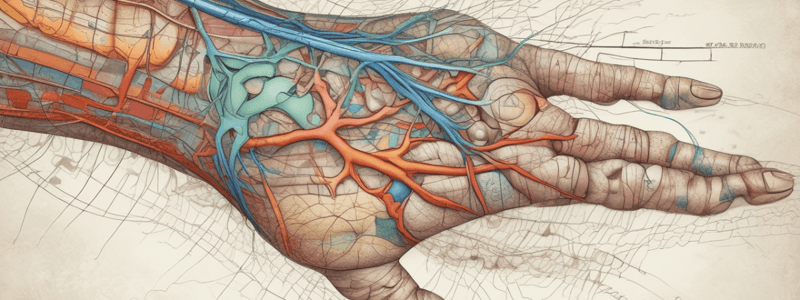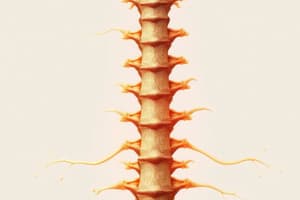Podcast
Questions and Answers
Which nerve root innervates the neck area?
Which nerve root innervates the neck area?
- C2
- C3 (correct)
- C5
- C4
Which nerve root provides sensation to the belly button?
Which nerve root provides sensation to the belly button?
- T4
- L3
- T10 (correct)
- S1
Which nerve root innervates the upper portion of the arm and shoulder?
Which nerve root innervates the upper portion of the arm and shoulder?
- C6
- C5 (correct)
- C4
- C7
Which dermatome covers the medial part of the lower leg?
Which dermatome covers the medial part of the lower leg?
Which nerve root is responsible for sensation in the palm of the hands?
Which nerve root is responsible for sensation in the palm of the hands?
What type of somatosensory symptoms are associated with lesions in the spinothalamic pathway?
What type of somatosensory symptoms are associated with lesions in the spinothalamic pathway?
Which nerve is primarily responsible for sensory input from the face in the context of somatosensory pathways?
Which nerve is primarily responsible for sensory input from the face in the context of somatosensory pathways?
In brown sequard syndrome, what sensory deficits are typically observed?
In brown sequard syndrome, what sensory deficits are typically observed?
What is a common cause of a transverse spinal cord lesion?
What is a common cause of a transverse spinal cord lesion?
Which thalamic nucleus plays a significant role in processing somatosensory information?
Which thalamic nucleus plays a significant role in processing somatosensory information?
What type of deficits are seen with central cord lesions affecting the spinothalamic fibers crossing in the ventral commissure?
What type of deficits are seen with central cord lesions affecting the spinothalamic fibers crossing in the ventral commissure?
What is the second most common cause of vestibular neuritis?
What is the second most common cause of vestibular neuritis?
Which condition can lead to blurry vision in cases of bilateral vestibular loss?
Which condition can lead to blurry vision in cases of bilateral vestibular loss?
In central vestibular lesions, what reflex involves the medial vestibular nucleus?
In central vestibular lesions, what reflex involves the medial vestibular nucleus?
Which combination of tests can help indicate whether a vestibular lesion is peripheral or central?
Which combination of tests can help indicate whether a vestibular lesion is peripheral or central?
What does an abnormal VOR but normal OKR indicate about a vestibular injury?
What does an abnormal VOR but normal OKR indicate about a vestibular injury?
What is the function of the primary sensory neuron in the posterior column pathway?
What is the function of the primary sensory neuron in the posterior column pathway?
Which of the following structures is formed by second-order sensory neurons after decussation in the caudal medulla?
Which of the following structures is formed by second-order sensory neurons after decussation in the caudal medulla?
Which type of sensory information is carried by the spinothalamic tract?
Which type of sensory information is carried by the spinothalamic tract?
What is the term used for the inability to recognize objects by touch?
What is the term used for the inability to recognize objects by touch?
What are the consequences of damage to the primary sensory neuron?
What are the consequences of damage to the primary sensory neuron?
Which of the following pathways carries information about upper and lower extremities?
Which of the following pathways carries information about upper and lower extremities?
Which type of syndrome causes loss of pain and temperature sensation unilaterally?
Which type of syndrome causes loss of pain and temperature sensation unilaterally?
Which vestibular sensory neuron is responsible for controlling head and neck positions?
Which vestibular sensory neuron is responsible for controlling head and neck positions?
Which vestibular sensory neuron projects via the medial longitudinal fasciculus (MLF) to the oculo-motor nucleus, trochlear nucleus, and abducens nucleus?
Which vestibular sensory neuron projects via the medial longitudinal fasciculus (MLF) to the oculo-motor nucleus, trochlear nucleus, and abducens nucleus?
Which test is used to measure nystagmus in response to short-duration auditory tones or clicks?
Which test is used to measure nystagmus in response to short-duration auditory tones or clicks?
Which organ in the vestibular system detects angular acceleration?
Which organ in the vestibular system detects angular acceleration?
Which vestibular sensory neuron is responsible for maintaining balance and extensor tone in limbs?
Which vestibular sensory neuron is responsible for maintaining balance and extensor tone in limbs?
Which type of syndrome causes vibration and position sense loss below the level of lesion?
Which type of syndrome causes vibration and position sense loss below the level of lesion?
Which test is used to measure nystagmus in all planes of motion?
Which test is used to measure nystagmus in all planes of motion?
Which vestibular sensory neuron controls the vestibulo-ocular reflex (VOR)?
Which vestibular sensory neuron controls the vestibulo-ocular reflex (VOR)?
Which organ in the vestibular system is gravity-sensitive due to the movement of stimulation?
Which organ in the vestibular system is gravity-sensitive due to the movement of stimulation?
Study Notes
Dermatomes and Sensory Pathways
- Dermatomes are sensory regions of the skin innervated by a nerve root.
- Major dermatomes include:
- C2: greater and lesser occipital nerve (head)
- C3: neck
- C4: top of shoulder (collarbone)
- C5: upper portion of arm/shoulder area
- C6-C7: upper half of lower arm and hands
- C7 & C8: palm of hands
- T4: nipple area (chest area)
- T10: belly button
- L3: knee
- S1: small toe, lateral foot, side of the calf
- L4: medial part of the lower leg
Sensory Pathways
- PCML (Posterior Column-Medial Lemniscus) pathway:
- Large diameter myelinated axons carrying information about proprioception, vibration, and light/fine touch
- Enter the spinal cord via the medial portion of the dorsal root entry level/zone
- Axons enter the ipsilateral posterior column to ascend to the posterior column nuclei in the medulla
- Maintain somatotopic organization (legs = lateral, arms = medial)
- Anterolateral pathway (Spinothalamic tract):
- Carry information about pain and temperature sensation and some extent of crude touch
- Test pain by the end of a toothpick and lightly touching the skin to see if an individual feels the sharpness
Trigeminal Nerve
- Innervates the face
- Main pathway to the thalamus is the trigeminothalamic tract
- Main thalamic nucleus: VPM (ventral posterior medial nucleus)
- Runs from lateral pons and medulla
- Functions: contains 3 nuclei that receive general somatic sensory inputs from CN V and other cranial nerves
Spinal Cord Syndromes
- Hemicord syndrome (Brown-Séquard syndrome):
- Interruption of the posterior column causes ipsilateral loss of vibration and joint position sense
- Contralateral loss of pain and temperature sensation in the anterolateral system, which is 2-3 segments below the lesion
- Transverse lesions:
- Sensory loss and pain = ipsilateral to the lesion
- Positive LMN symptoms at the level of the lesion
- Central cord syndrome:
- Small lesion: damage to spinothalamic fibers crossing in the ventral commissure causes bilateral regions of suspended sensory loss to pain and temperature
- Causes: syringomyelia (fluid-filled cavity in the spinal cord), tumors, and MS
Primary Sensory Neurons
- Bifurcate: ascending axons enter the posterior column
- Synapse on the respective nucleus
- Second-order sensory neurons cross the midline in the caudal medulla and synapse in the thalamus
- Decussate as internal arcuate fibers and then form the medial lemniscus on the other side of the medulla
PC-ML Pathway Symptoms
- Loss of position and vibration sense (limb orientation)
- Loss of discriminatory touch (2-point discrimination)
- Crude touch preserved
- Astereognosis: inability to recognize objects by touch
- Sensory 'ataxia': unsteady balance and gait, poorly coordinated movements
Vestibular System
- Cochlea: detects sound waves
- Semicircular canals: detect angular acceleration
- Utricle and saccule hair cells in the ampulla are all oriented in the same direction
- Otolith organs detect linear acceleration and are gravity-sensitive
- Vestibular sensory neurons: lateral vestibular nucleus (LVN), medial vestibular nucleus (MVN), superior vestibular nucleus (SVN), and inferior vestibular nucleus (IVN)
Studying That Suits You
Use AI to generate personalized quizzes and flashcards to suit your learning preferences.
Description
Learn about major dermatomes for legs & feet, arms & hands, and trunk. Understanding dermatomes is useful in identifying the site of a lesion. Explore how sensory regions of the skin are innervated by specific nerve roots.


